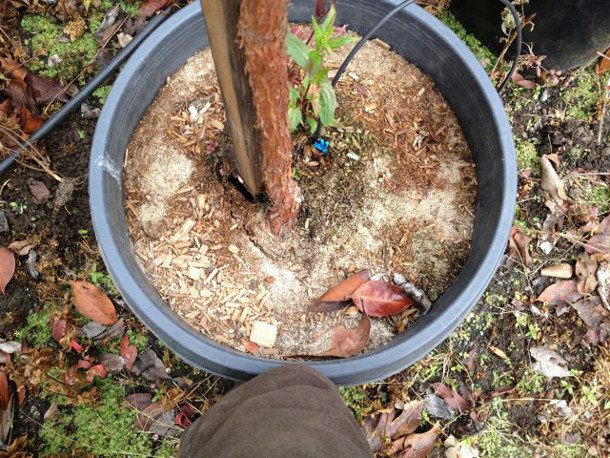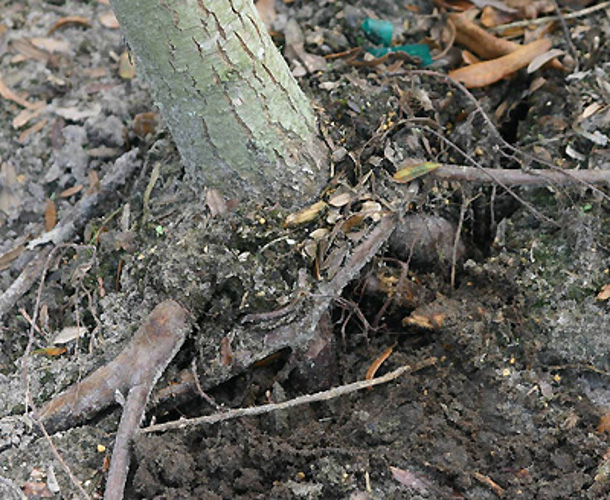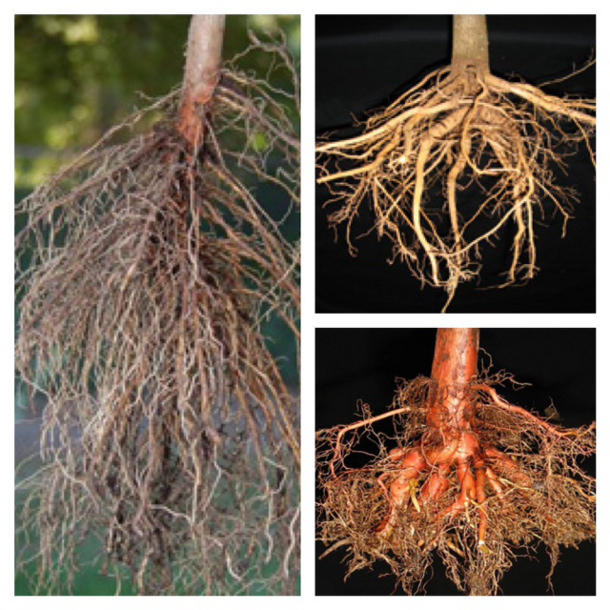The research has been out for a while now: circling, girdling, diving and kinked roots in the nursery pot lead to poor health, blown-down trees and shorter lifespans. With budgets for greenery shrinking, every tree or shrub has to last for a while.

Growing in a series of containers can lead to rootballs within rootballs. Image on left by Dr. Ed Gilman.
What if you could reduce replacement costs, prevent a certain amount of injury or damage caused by falling trees – and actually save money up front? Start by planting smaller stock – #5 containers instead of 15s, 15s instead of boxes. Smaller plants are less prone to transplant shock, grow faster and have fewer, more easily correctable root defects. Save money on not only the plants themselves, but the labor to install.
No matter what size you plant, follow this procedure: inspect, correct, reject, pass it on!

The crack in the soil to the left of the trunk indicates a probable circling or diving root at this location
Inspect: Shake the tree in the nursery pot. Often, you’ll see a crack in the soil as the tree moves, indicating the true extent of the woody roots. The woody roots are the oldest roots. They are the ones that hold the tree up. If they aren’t pointing outward from the trunk, they won’t provide effective support.

This girdling root provides no support, allowing the tree to easily tip over. Photo by Ed Gilman
Brush away the top inch or so of the soil and look at the larger woody roots. Do they wrap (girdle) the trunk? Do they circle the outer edge of the rootball? (this is often not the outer edge of the container) Do they grow outward then dive down at a 90-degree angle? Do they curve under the trunk or resemble a ball or knot?

Examples of good root systems. Photos by Ed Gilman
If they actually grow straight out from the trunk all the way to the edge of the container, you have a winner. But in most cases, you will have to do some root correction.

Prune diving roots just before they make the 90-degree turn so the remaining roots point outward from the trunk. It’s easier on younger trees. Photo by Ed Gilman
Correct: Some defects are correctable. The goal is to have all roots pointing straight out from the trunk. Small girdling or circling roots may be unwrapped and manipulated into position. Larger inflexible ones have to be removed at the origin. Cut diving roots at the point just before they dive downward. Roots will grow at the cut ends in the direction the root is pointing.

A circling root can turn into a girdling root as the trunk size increases. This root is much harder to prune now – should have been done at planting time.
Young, healthy trees can survive a fair amount of root pruning, as long as they are adequately watered afterward. Dr. Ed Gilman’s research and the field experience of many shows that pruned roots will regrow after pruning.

These roots are not correctable. Corrective pruning won’t make them point outward. Photo by Ed Gilman.
Reject: This is difficult, as many of our projects are time-sensitive, but some defects are not correctable. If roots cannot be pruned or manipulated so that all roots point straight out from the center, don’t waste your valuable funds on this tree. Whenever possible, we may need to build flexibility into our planting lists or timelines to get the necessary quality.
Pass it on! Train your crews (paid or volunteer) in identifying and correcting root defects. Educate your colleagues and customers. Contact your local nursery and tell them something like this:
Trees and woody plants grown in containers often have circling, girdling, kinked and diving roots due to the growing process. If not corrected at planting time, these can lead to premature decline or blowdown causing damage and injury. We can correct some of these at planting but some root defects are not correctable. It can be difficult to find trees at your nursery with correctable defects. We must inspect, correct or reject tree and shrub rootballs to ensure a long-lived product and meet professional standards. Please help facilitate our inspection process and prevent defects by changing your growing practices. Read “Strategies for Growing a High-Quality Root System, Trunk and Crown in a Container Nursery” for more details.
Ellyn Shea is a consultant and garden educator in San Francisco.






Leave Your Comment